If there’s one thing we’ve all had to reconcile in 2020 it’s the effectiveness of social media to move people to take action. That’s good news for nonprofit organizations as we head into the busiest time of the year for fundraising. Social media can be a powerful tool to help nonprofits boost their visibility, broadcast their missions, and gain supporters.
🎵 It’s the most wonderful time of the year. 🎵 Part of the “wonder” of winter is that it’s easier to get people into a giving mood. Whether the giving is incentivized by a tax write-off, the need to make room for the new stuff or just plain ol’ holiday spirit, the five-week period from Thanksgiving Day to New Year’s Eve has traditionally been the busy season for nonprofit organizations.
As this year comes to a swift close, it’s important for nonprofits and charities to include social media as part of their overall holiday marketing strategy, beyond just Giving Tuesday.
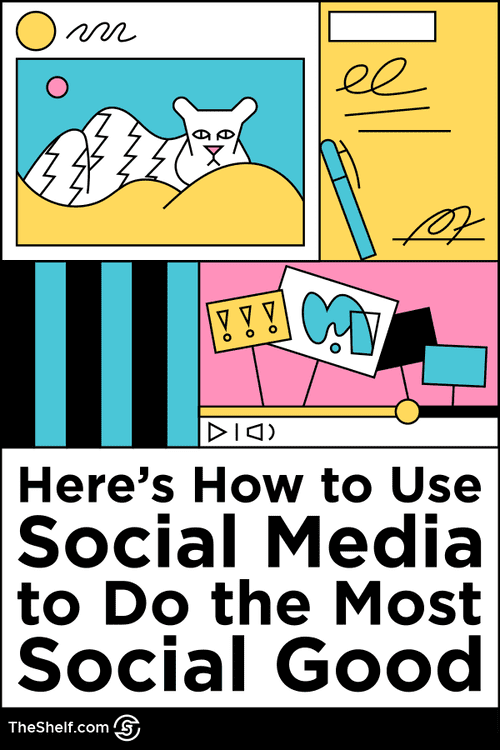
Thirty percent of annual online donations to nonprofits happen in December, and ten percent of all annual donations are given on the last three days of the year. Nonprofits have dubbed the last quarter of the year as Giving Season for a reason. Americans will give $450 billion in donations this year. So, the onus is on organizations to articulate their value in such a way that donors will jump at the opportunity to be a part of their missions. Let’s talk numbers then we’ll talk strategy. If you want to skip right down to the strategy, go for it.
The Success of #GivingTuesday Pretty Much Proves Social Media’s Value to Nonprofits
The first big event to kick off the year-end donations is probably Giving Tuesday, a movement that started in 2012 as a hashtag holiday. In 2019, participating non-profits raised $511 million through their online efforts. That’s an increase of almost 28 percent from 2018’s $400 million raised.
#GivingTuesday has over 20 billion social media impressions. Not bad, considering the movement launched in 2012. Over the years, #GivingTuesday has not only grown, but organizers have gotten much better at doing targeted, data-driven social media marketing. There’s even an entire section on GivingTuesday.org dedicated to social media graphics that supporters can download and use across their own social channels.
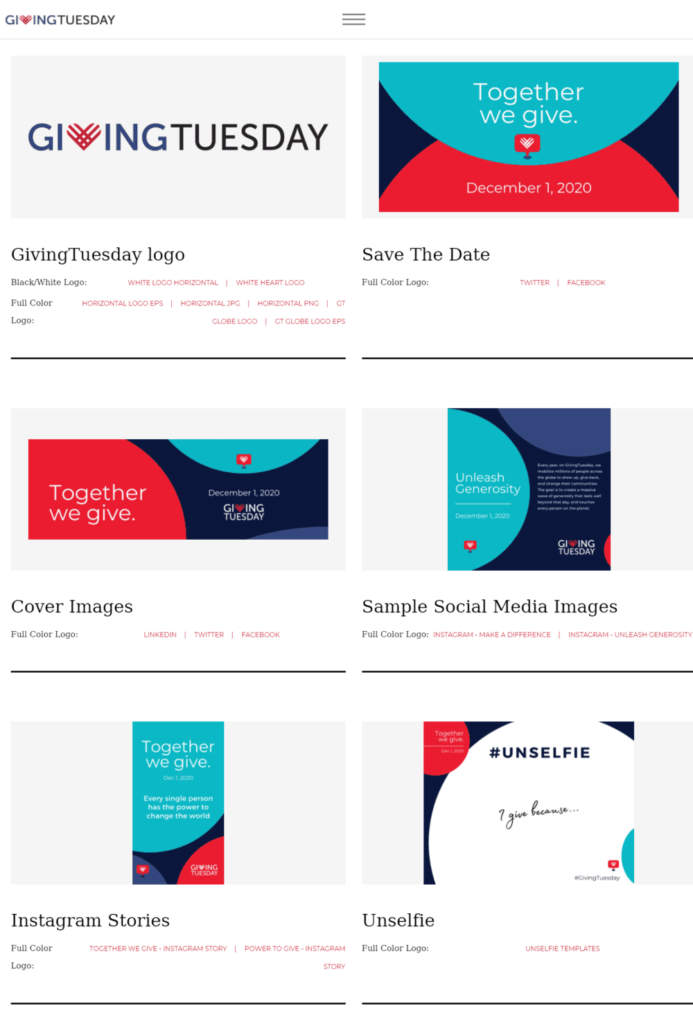
Over the years, Giving Tuesday has grown consistently:
- 2012: $10.1 million
- 2013: $28 million
- 2014: $45.7 million
- 2015: $116.7 million
- 2016: $168-$177 million
- 2017: $274 million
- 2018 $400 million
- 2019 $511 million
This 2020 Giving Tuesdays will happen on December 1st and was expected to generate more than $605 million in online donations pre-COVID-19. With donations already lower than expected and many nonprofits fighting to stay afloat, compounded by the challenges the US economy faces holistically, things feel uncertain.
WHY GIVING TUESDAY IS SO SUCCESSFUL
An important part of Giving Tuesday’s success comes from the organization’s partnerships with well-known organizations like Facebook, PayPal, and Classy which provide multiple ways for people to easily donate. Sometimes just a screen tap gets the ball rolling.
Giving Tuesday also relies a lot on historical data and psychographics to determine how to target audiences.
Taking these preliminary steps allows Giving Tuesday to ensure their efforts translate into monies raised, volunteers recruited, and pretty high brand visibility. And that’s where social media becomes extremely valuable.
It’s no secret social media content can be compelling enough to drive significant actions, from silly TikTok challenges that are a perfect way to get eyes on your campaign, to actually compelling people to buy.
Social media is how we communicate; it’s how we keep in touch with the people, brands, and organizations we love (and animals – I’ll never stop following you, Wilfred Warrior). It’s where we go to get ideas, discover new products, and learn new things.
The great thing about social media for nonprofits is that no matter what your goal actually is, there’s a way to use social media content to help your cause. So, without further ado (and since you came here looking for social media tips for nonprofits), I’m going to share five proven tactics nonprofits have used to leverage social to get amazing results. Use these tactics in your year-end holiday campaign.
#GIVINGTUESDAYNOW
This year has been especially hard on humanity. COVID-19 has taken the lives of 1.06 million of our moms, dads, siblings, best friends…loved ones. Over 20 million people lost their jobs, and over half of them are still out of work. We’re all still feeling the sting of global uncertainty, and we’re doing all that we can to manage both individually, as productive members of a cohesive community.
At the end of March 2020 the GivingTuesday team realized what we were up against. Even before most government officials did. The organization announced that in response to the COVID-19 pandemic, they’d like to organize an additional day of giving. Rather than waiting until Giving Tuesday 2020, they set a goal of May 5, 2020. In weeks leading up to what was coined as #GivingTuesdayNow, the organization was able to spread the word on a global level, and rally worldwide support for victims of the pandemic and their families, fight racial injustice, respond to crisis, and strengthen communities; giving a voice to those who feel unheard.
As they shared their vision of a more generous world, their philosophies became contagious, the result was social media mentions in 145 over countries. Giving, collaboration, and action from millions of individuals, businesses, nonprofits, communities and global brands skyrocketed as they refused to back down during times of economic uncertainty.
GivingTuesday Data Commons tracked the real-time theme of sentiments and conversation. What they noticed is an extreme emphasis on the idea of unity, togetherness, and unity with conversation volume growing throughout the day and shifting to action-oriented messages highlighting support and donations.
In addition to raising over $503M in donations in the US alone, this special day empowered youth to spearhead movements that would lend change to issues that overwhelmingly impact youthful thought leaders including student debt, climate change, and health care reform. GivingTuesdaySpark, formally GivingTuesdayKids is focused on expanding youth engagement to develop and support civically engaged youth, not just in the United States, but all over the world.
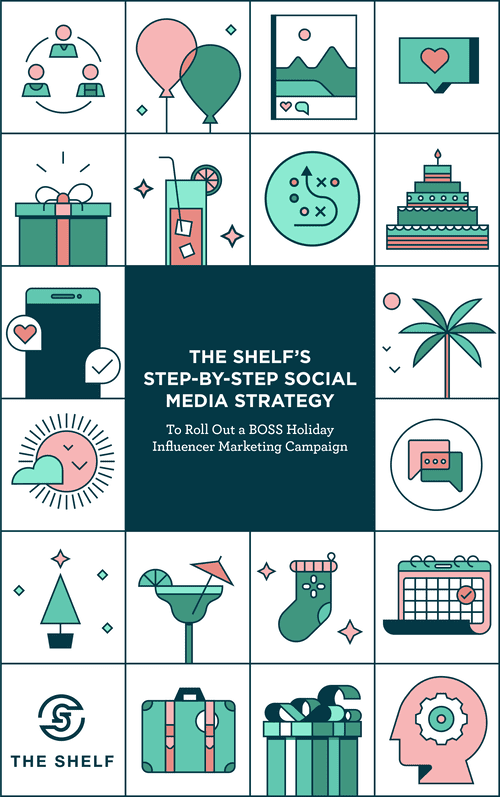
Download The Shelf’s Holiday Influencer Marketing Guide
Complete this form and hit submit, then check your email for a copy of The Shelf’s 11-Step Holiday Influencer Marketing Plan 👌 packed with stats, trends, and of course, a KILLER influencer marketing strategy… just in time for your winter campaign. Happy converting! 👍 Email*
How Nonprofits Can Use Social Media Content to Drive Awareness and Boost Support This Holiday Season
Big Idea: Transparency is More Important Than Ever. Use Content to Boost Yours
We recently published the Real Influence report, in which we collected hundreds of pieces of data chronicling influencers’ involvement in social and political movements, but also their push to demand accountability, diversity and transparency from brands. That’s a big deal, and really important for nonprofits to understand because a lot of us don’t donate to non-profits because we don’t really know if they’ll use the money for its intended purpose. By definition, a nonprofit organization is just a company that doesn’t dole out profits to shareholders – the profits go toward the mission.
Which means…
If a nonprofit is just barely covering operating expenses (building, utilities, staff, insurance…), there isn’t much money left to put toward a mission. Knowing that makes us cringe in all sorts of ways.
According to the Trends in Giving Report 2018, 12 percent of would-be donors don’t make donations because they don’t trust the nonprofit organizations will spend the money well. Two percent of us don’t even think our donations will make a difference.
A lot of people are concerned about how the nonprofit will spend the money they donate. They’re worried, and sometimes even convinced, they will never see the actual impact of their donations. Or worst, that there won’t be any. This is all bad news that you can flip into a good opportunity to KILL IT with your social media content.
CONSTANT COMMUNICATION IS KEY
You know how that one “introvert” in your friend group is sort of off-putting because he rarely says anything. (Or remember Prince?) Uh, yeah… that’s your NPO if you’re not actively in fundraising/development mode.
In addition to doing active outreach to get support, it’s also smart to keep your organization, mission, and team highly visible, particularly on social media, your website (say goodbye to those Web 2.0 static pages), and via email.
% of Donors Who Say Communication Tool Most Inspires Giving

| This chart shows the percentage of surveyed donors in each region who identified these four types of communication tools as the ones most likely to inspire them to give. Source: 2020 Global Trends in Giving Report. |
WHAT KIND OF CONTENT SHOULD YOU CREATE?
Social media is going to be your secret weapon for building brand awareness and getting people to want to support your mission. Do that by telling stories about your organization, its supporters, the founders and team members, and especially the people directly impacted by your mission.
Social media and email work together. For donors, they are the two most preferred media for communication with nonprofits. Social media because it allows you to keep your community up-to-speed on what you’re working on in real time. That means your followers and your supporters can get up-to-the-minute news on how you’re helping, and where their donations are going… in a real and relevant way.
This time of year, holiday email marketing is critical for nonprofits and for-profit companies alike. In the US and Canada, regular email communication is 3X more likely inspire repeat donations than regular social media communication. Social media can help you get the visibility you need to create an opportunity to get that emotional investment the captions + images are so good at drive clicks over to your site.
Consider this example from Charity: Water (@charitywater). This non-profit’s goal is to bring clean and safe drinking water to communities in developing countries. An impressive 100 percent of the donations people give go directly to this cause (you can check financial reports and everything) and the Charity: Water social media engine does a really good job of promoting transparency, highlighting what the organization does using social media content.

The organization has a series called The Journey in which team members travel to each of the communities Charity: Water is helping get clean water. When you watch the videos you get to know the place, the people they’re helping and how clean water is improving their lives.
If you scroll the organization’s Instagram feed, you’ll see photos and videos that simply tell the most amazing stories. Most of these posts focus on the people benefiting from Charity: Water’s work. Yes, from time to time you’ll see footage of people drinking dirty water. But for the most part, the content they publish has a positive note.
The goal of the content is to build trust by letting followers know the money they donate is going toward its intended cause.
USE TRANSPARENCY TO BUILD TRUST
If appropriate, create a campaign where you work with a few of the people who have benefited from your organization’s efforts to just share honestly how you’ve helped. Ask them to share their holiday traditions, or plan an Instagram takeover ask them to create content themselves, on their own. The goal here is to feature real people who have real lives. This isn’t about using people to get more donations in. You just want your followers to associate your organization with real people.
Show people how the money they donate is spent. Financial reports are great, but explaining those reports is better. I’m gonna give a very simplistic example here. If you’re collecting money to buy food to give away, show the journey of 10 dollars from the donation to the moment where people receive the food. Almost every non-profit has a fundraising activity for the holidays, how can you adapt this idea to the money you raise and how you spend it?

Big Idea: Call in the Slacktivists and Get the Word Out
Be honest. We’ve all been slacktivists at one point in our lives. You know… sharing photos of the Amazon burning with the hashtag #PrayForAmazon without actually getting out of our house (or PJs) and doing something about it. Or even praying about it. Slacktivists are great at signing online petitions, sharing social media posts, and doing whatever they can do to help a cause…as long as it doesn’t require them to put down their phones or change thier plans or show up anywhere for anything.
The truth is that many slacktivists have no idea how they can help. And, when money is involved, many of them don’t have the means to make a donation (43 percent of non-donors say they don’t donate because of that).
So here’s what I think: social media is a great way to educate the people who have no idea how to help… but also, since slacktivists will always be, social media is a great way to rally these people specifically to share content and spread the word with no further commitment required or even expeced.
Slacktivists aren’t big on commitment, but they are masters at using social proof to boost brand awareness.
The first thing that comes to mind on this is #Kony2012. (It’s been long enough, right?)
This was a campaign launched by an organization called Invisible Children. The goal was to bring Joseph Kony, the military leader of the LRA in Uganda, to justice for all the atrocities he had committed for over 20 years by making him famous. The campaign wanted him out of the shadows in hopes that the world would hold him accountable for his actions.
The campaign kicked off with a YouTube documentary that went viral, getting 100 million views in the first six days.
Crazy.
In the words of Invisible Children, the video “proved that if people knew about Kony’s crimes and were given the chance to help, they would step up.”

What made this campaign unique and powerful, was that people were so moved by the documentary that they began talking about the campaign across social networks, and looping in people they thought could help bring change by tagging them in posts.
So, all of a sudden, people were calling on celebrities and policymakers in their tweets, videos, and Facebook updates, asking them to go get Kony. And it worked. There were posts and shares and tweets and retweets from the biggest celebrities in the world at that time – Justin Bieber, the Kardashian/Jenner clan, Rihanna… Everybody was talking about this campaign. But that’s just the thing… people were only talking about it.
The campaign raised tens of millions of dollars for Invisible Children. And if that had been the primary goal, I would say the campaign was a HUGE success. It got massive visibility, and made both Joseph Kony and Invisible Children trending topics across the world. Traditional media picked up the story and things went sideways, for sure. I left a link to the original documentary at the top, but the video below does a great job of recapping the campaign and the results of the campaign.
Although there were many questions about the video and intentions behind it, this is one of the most successful awareness campaigns in social media history. it made politicians put forward a resolution, though as of now, Joseph Kony is still at large and the US is not making any effort to find him. Also, he’s not famous anymore. As for Invisible Children, they still exist and they help communities affected by the LRA.
USE UGC TO BUILD BRAND AWARENESS – SLACTIVISTS WELCOME
Ensure there’s room in your campaign where people can do their part just by sharing content. Only a fraction of those interested in a cause will take up the mantle and run with it. So, your goal is not to get 100 volunteers. Your goal is to get 100,000 shares and the volunteer part will take care of itself (because sales – all sales – is a numbers game).
Take the premise of “making something famous” and ask people to share it… nothing else. After people do it, thank them personally if you can with a tweet, a comment on their post, or adding them to your Stories. A simple “thank you” goes a long way. And now’s the time for giving thanks!
Don’t forget: have a specific goal for your slacktivist campaign so you can measure the effectiveness of your efforts. People are going to share your content but for what? You want to increase your reach, likes, or retweets? Do you want to get to people with more resources? Ask yourself this before planning it.
Also, be a good nonprofit neighbor. Share other causes from organizations participating in #GivingTuesday or those running holiday fundraising campaigns that may be of interest to your audience. Encourage your followers to check out those causes as well and share their content.

Big Idea: Inspire Donations
There was a terrible earthquake in Mexico in September of 2017 (I lived it first-hand since I live in Mexico). A lot of buildings literally fell down. Many people were injured and, sadly, many also died. During the days after the earthquake, it was through social media that I was informed about all the things that were happening in real-time.
There’s a rescue group called Topos (translated as moles) that helps in situations like these. They act as moles by searching for and rescuing people trapped beneath the ruins. The Topos is made up of volunteers. They are Mexican but they also go out to help help wherever they may be needed. For example, they helped to rescue people Haiti after the big earthquake in 2010 and were on-site rescuing people in Nepal after the earthquake in 2015. When I donated to them in 2017, I did it because they uploaded a video.

The video was recorded with a phone, it was unedited and you had to turn up the volume to understand what the guy was saying. He said plain and simple how they were using the money and what did they still need. The roughness and honesty of it made people know how urgent it was to help. The easiest way of helping was by donating money.
Like me, many didn’t have the means to go and help in person. Approximately 3 billion Mexican pesos (that’s around 150 million dollars) were donated to causes related to the earthquake. And there are tons of stories just like this one of Mexicans helping one another – everyday hero-style.
According to the Trends in Giving Report, in 2018 29 percent of people who donated to any cause were inspired by social media to do it. The most popular platform to inspire Facebook.
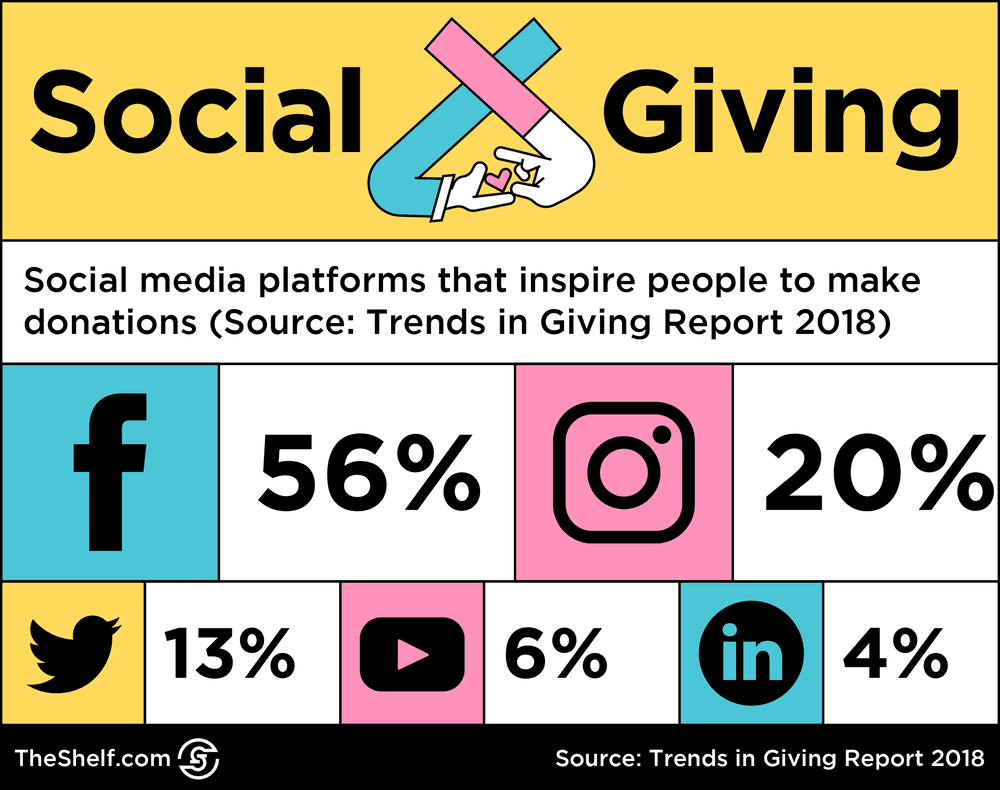
COPY AND PASTE THIS 👇 CODE TO EMBED THIS ☝️GRAPHIC.
One big takeaway from this tactic is you have to make it very easy for people to make donations or otherwise contribute to your cause. If you don’t, you’re seriously jeopardizing that donation.
If your fundraising efforts are ongoing, make it easy for people to do it! More than half of the people who donate money do it online… and 25 percent of them do it through social media.
Facebook donate
I don’t know how you raise money but if you’re not using Facebook Fundraising, check it out. This feature is not available everywhere (here’s the list of countries where Facebook Fundraising is available). Don’t worry, it’s available in the US and a lot of European countries. Also important, consider that people can raise funds on your behalf. You may have seen a Facebook alert about a friend’s birthday and the CTA for their birthday is that she wants you to donate to a certain cause.
Making a donation through Facebook Fundraising is easy. It’s so easy that 88 percent of the people who have used it say they would use it again. Also, it’s free to use and Facebook doesn’t take a percentage just for facilitating the donations.
Another tool Facebook has is the “fan subscription.” I actually just realized this tool exists because of the Wildcat Sanctuary Facebook page. This tool is made especially for creators and you can check how to start using it here. The system is similar to Patreon and it’s only available to a limited number of creators (but who knows, if you have an engaged community, you might be eligible!).
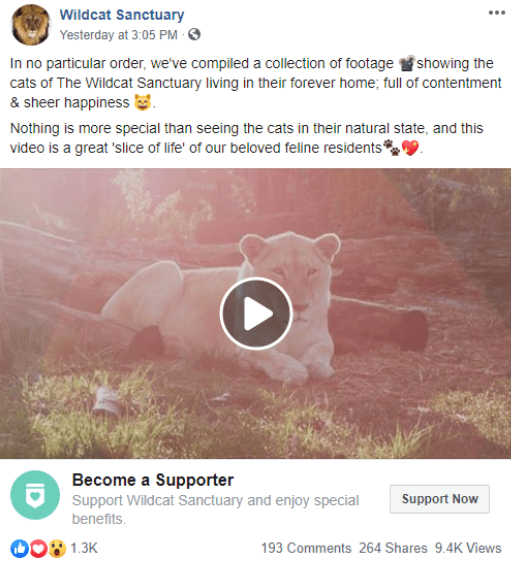
Instagram donate?
This feature is only available in the US and it’s a button you can share on your Instagram Stories, alerting your followers that you’ve launched a 24-hour fundraiser. To use it, your Instagram business account must be linked to your Facebook page and you have to be registered as a non-profit (check the ins and outs here).
The cool thing about the Donation sticker on Instagram is that if your non-profit follows the process, people can also raise funds on your behalf! Yep, they can share a Donation sticker on their own IG Stories to help you.

The best way to do this I think is to do something like Giving Tuesday has done and create messages and images ahead of time that people can use on their own social media channels. That way, you ensure your messaging and you need are clear and consistent no matter where they happen to show up.
USE INSPIRATION FOR SOCIAL GOOD
Create a campaign that allows people to help you raise your money. During the holidays, people spend more on gifts, food, and social activities. Ask your more loyal fans to skip takeout the day after Thanksgiving or challenge their friends or their followers to go one week without their pumpkin spice or peppermint coffee and donate the money to a good cause.
Giving on behalf of another is also a great idea! What if you ask your community to make a donation in the name of a loved one and give that as a present during the holidays? I’d go crazy if somebody donated to an animal cause and gave it to me as a present. Family and friends who are reading this: this is the present I want, don’t forget.
People are willing to give if they have a compelling reason to do so. The Salvation Army Santa standing outside the grocery store know this. Sometimes giving is just about being in the right place at the right time – just being visible.
Other times, you need to inspire people to give. Invite your followers to use tools like Facebook Fundraising or the Donation sticker to help you raise funds. And be sure to thank all of the people who raised money for you on your social media accounts.
Big Idea: Referrals Can Get More Volunteers
Depending on the non-profit you run, it’s possible that a lot of work gets done by volunteers. Eighty percent of non-governmental organizations agree social media is very effective to recruit volunteers, your nonprofit can do it ,too! Maybe you already have a recruiting system, like getting sign-ups on your website or going to volunteer events to get people interested in your cause. The question is how do you incorporate social media into your nonprofit’s recruiting activities?
The first step is to your current volunteers happy. Make them your champions. Use social media to stay in the loop with them. Follow them, comment on their volunteering photos, and share what they do for your nonprofit (if they’re cool with it). Make a private group (Facebook is a good place for this) and ask them how they feel. Find out what they need to do more faster, or to offer their services and get more out of the experience. You may be able to even get ideas on how to recruit other volunteers. Think about creating a poll that would serve as the first step in creating a kind of volunteer referral program.

Once volunteers are involved, it’s easier to reach new people! Ask them to mention the social handles of your nonprofit and create a cool, unique hashtag specifically for your volunteers to use. They’re probably already sharing them. Working with local influencers can also be useful. Invite them to volunteer and ask them to share their experience on social media.
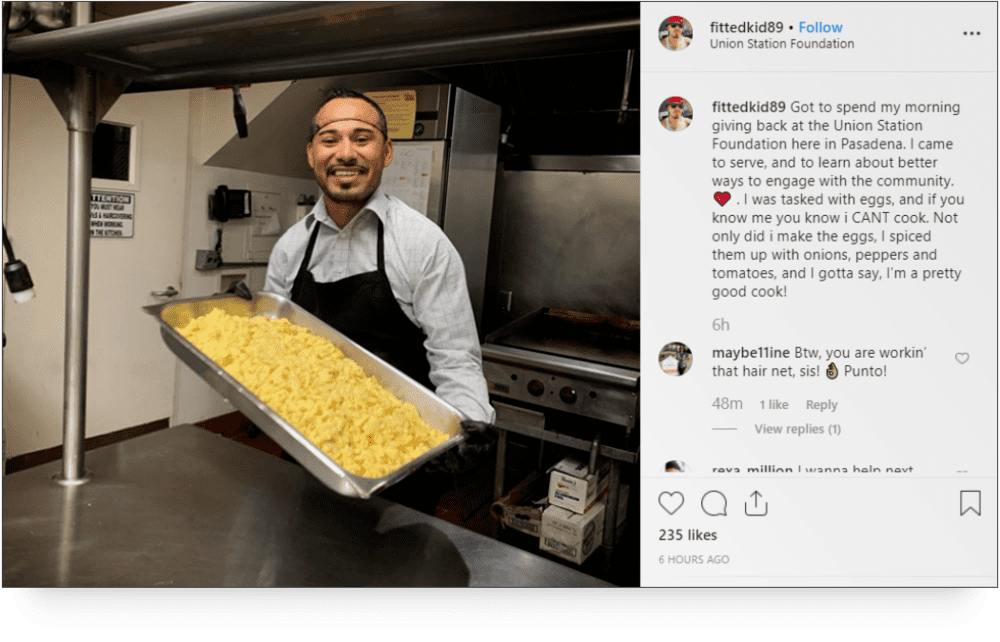

USE REFERRALS AND EMPATHY TO RECRUIT VOLUNTEERS
People ARE willing to help during the holiday season, and your nonprofit may already have plenty of volunteer this season. Well, you can strengthen your bonds and get your volunteers talking about their experiences treating them like customers and be responsive. Show the people who want to help you that you appreciate them and provide them with ample opportunities to partner with you again, hopefully at different points in the coming of the year.
Another idea for getting more volunteers on board is to share your sign-up forms on social media. If you can, build a special section on your website where people can know about volunteering opportunities and how to help. Check this tweet from the American Cancer Society:

What I also like about this tweet is that they mention a very common excuse people have when they’re asked to volunteer: not having enough time. This is another way of having a close relationship with your volunteers will help you. You’ll get to know them better and you can head off the excuses by attacking pain points head on in your social media posts. With kindness, compassion, empathy, and a little love, of course.
So yes, you don’t need time, you just need a heart… and you already have one! Once you notice you have a heart (in case you didn’t know) you click on the link and get to a special volunteer page from the American Cancer Society. There, there are many options for you to volunteer, from driving to sharing your experiences with others.
Make a #GivingTuesday or winter holiday campaign based around the idea that volunteers give the greatest gift – time. Create those branded hashtags and use the reach your hashtags get to recruit new volunteers. Show your volunteers the impact they are having on their community by showing them how their efforts progress the mission.
Big Idea: Collaborate with Brands, Nonprofits and Influencers
Did you know 73 percent of Facebook users expect companies to actively contribute to society? It’s true that many companies and brands have initiatives of their own, but they can also work with nonprofits to push community-based or globally-based initiatives forward. When two organizations partner, they can reach more people and have greater impact.
On social media, a collaboration with a complementary organization whose mission can run alongside yours can help you reach new audiences. For example:
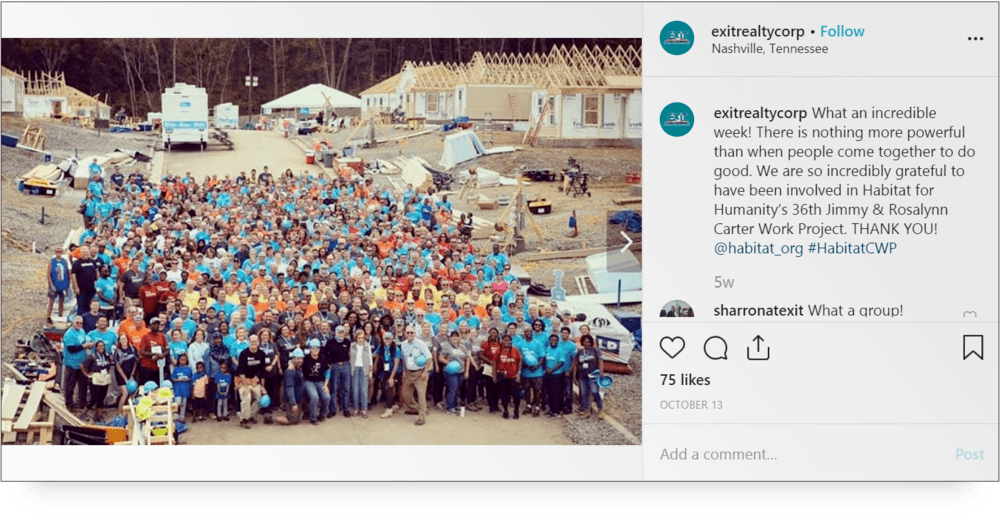
This company’s employees volunteered for Habitat for Humanity and they shared a photo of that on their Instagram account. They mentioned Habitat for Humanity and used the official hashtag of the project. It’s as simple as that! Just ask the companies to mention you on their social media accounts!
Another thing you can do is to collaborate with other non-profits. For example, Arms Around You and Abundance of Hope joined forces on a winter clothing drive. Both non-profits shared the information about the drive on their social media accounts and tagged one another. Plus, they got even greater visibility by tagging their sponsors.

Collaborations are win-win agreements. And these are collabs you can do with brands, other nonprofits, charities, or influencers. Besides making it much easier to hit your targets, they can give your content feet.
USE COLLABORATIONS THIS HOLIDAY SEASON
I’m sure that there are many brands and non-profits you admire for their work. Why not make that list public on your social media accounts? It would be a great idea to thank them for their work (especially for Thanksgiving and Christmas, for example).
Just like the example above, joining forces with another non-profit for #GivingTuesday can introduce your cause to new potential supporters because you’re hitching your wagon to more than a hashtag or a movement, you’d be partnering with an idea, a place where people go when they’re looking to get involved. Use the power of networking to help you get the news about your organization and its mission out to the masses.
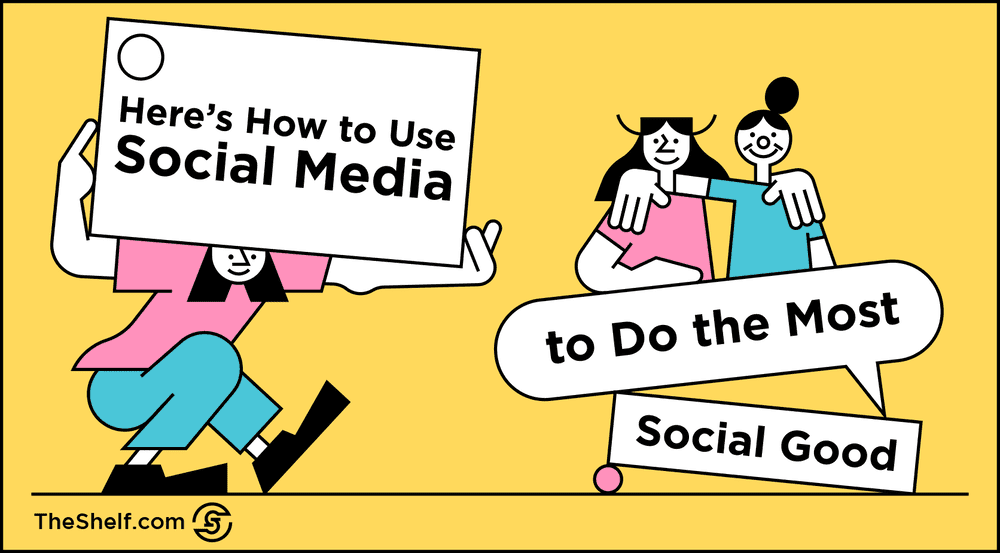
A Final Word…
I know. I know. Your day is filled with a million other things you HAVE to do. Social media probably isn’t one of them. But, the power of social for sharing messages and drumming up interest is undeniable. When used strategically, it can consistently shorten the time it takes you to launch and see real results with your campaigns.
Yes, it takes time and energy to keep your audience in the loop with great social media content. Yeah. But it’s the best and fastest way to get your supporters to trust you and align themselves with your mission.
There are hundreds, and even thousands, of nonprofit organizations doing amazing things to serve the global community with the resources they have, and most of it never reaches social media. My invitation here is to share what you’re doing! Don’t be afraid of it appearing as if you’re bragging. Other people will start to brag for you if you truly add value.
Go ahead and share what you’re doing and how you’re doing it. Introduce us to the people that volunteer every month, even when they’re exhausted. Let us know the name of the people who work with you and who inspire one another to do their best. Explain to us why your cause is important. And show us how we can help.
It doesn’t matter what your cause is, social media levels the game for big and small nonprofits providing an opportunity to champion their cause and to become more of an asset to the families, the communities, the world that we serve.



